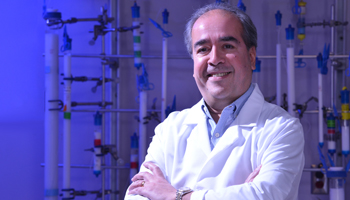HOW CAN WE HELP YOU? Call 1-800-TRY-CHOP
In This Section
Dr. Krishnaswamy Recognized for Groundbreaking Research of Blood Clots

Sriram Krishnaswamy, PhD, received the ASH 2019 Ernest Beutler Lecture award for his significant research contribution to the understanding and treatment of blood clots
By Nancy McCann
A big congratulations goes out to Children’s Hospital of Philadelphia researcher Sriram Krishnaswamy, PhD, as the American Society of Hematology (ASH) honored him with the 2019 Ernest Beutler Lecture award for his significant scientific contributions to the understanding and treatment of blood clots.
The Ernest Beutler Lecture, named for the late Dr. Beutler, past president of ASH and physician-scientist for over half a century, is a two-part lectureship recognizing major translational advances related to a single hematology topic. The 2019 award honors Dr. Krishnaswamy, also a professor of Pediatrics in the Perelman School of Medicine at the University of Pennsylvania, for enabling advances in basic science, and Jeffrey Weitz, MD, McMaster University, Hamilton, Ontario, for clinical science/translational research.
Drs. Krishnaswamy and Weitz, who have devoted their careers to hematology, presented the lecture, “Blood Coagulation: From Molecular Mechanisms to Treatment of Thrombosis,” Dec. 9, during the 61st ASH annual meeting in Orlando, Florida. The lecture explored the bench-to-bedside development of novel anticoagulants of venous thromboembolism.
A worldwide health concern, venous thromboembolism (VTE), abnormal blood clots in veins, are responsible for over 100,000 deaths in the United States per year. In the U.S. and Europe combined, VTE-related events kill more people than AIDS, breast cancer, prostate cancer, and motor vehicle crashes combined.
Novel Anticoagulants
“The novel anticoagulants we have access to today for blood disorders and many other conditions began with key insights made in the laboratory, and there is a clear translational path from the laboratory to the bedside.” Dr. Krishnaswamy said in an ASH press release.
Dr. Krishnaswamy spoke of the molecular mechanisms of thrombin formation — the enzyme that makes a blood clot. Vascular damage triggers a series of activation steps that culminates with the generation of thrombin.
“It is a highly regulated system because if you have too little thrombin, you don’t form a clot quickly enough, and you bleed,” he said. “Whereas if you have too much thrombin, then you potentially could occlude the blood vessel, which is disease causing and can potentially lead to death.”
Of course, blood coagulation is more complicated because you only want the clot at the site of injury, he continued. Not upstream. Not downstream. This is possible because in blood, all the precursors are inactive — they are created on demand, he said with the snap of his fingers, at the site of injury.
“What you want is a small, initiating stimulus to get a big response, that’s then shut down,” Dr. Krishnaswamy said. “That’s how you get this type of localized clotting process.”
New Ways to Modulate Coagulation Reactions
Dr. Krishnaswamy enlightened the audience with newly uncovered molecular mechanisms that show the way for the future of how to interfere with the coagulation reactions, and, ultimately, inform novel treatments for blood clots. By deciphering the mechanisms through which membrane-bound clotting factor complexes function, he described how the incorporation of factor Xa into the prothrombinase complex modulates its specificity and efficiency to promote thrombin generation. In other words, how these clotting enzymes assemble, how they work, and why you need a clotting enzyme complex to function biologically as opposed to just the enzyme.
The ideas that have underlined the development of the current crop of inhibitors, direct oral anticoagulants (DOACs), rely on the older perspective that just understanding the catalytic site of the enzyme is sufficient to comprehending how these enzymes work specifically, Dr. Krishnaswamy explained.
“But there is a lot more that goes into it that previously was not well understood,” he continued. “The current drugs work pretty well, but there are likely better ways and safer ways that leverage the increased appreciation of the biochemistry of these reactions. If you inhibit clotting, you’re going to cause bleeding, so the objective is to inhibit thrombosis without increasing the risk for bleeding. That’s what it really comes down to.”
At CHOP Research Institute, Dr. Krishnaswamy and a multidisciplinary group of researchers are working on a five-year Program Project Grant “Hemostasis and Thrombosis: Chemistry, Biology and Physiology” from the National Heart, Lung, and Blood Institute to investigate how blood coagulates.